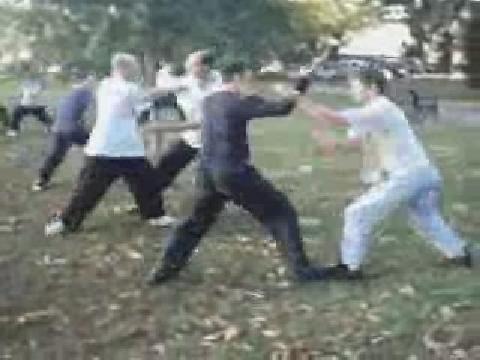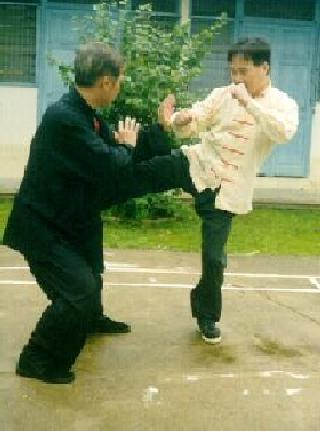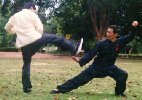September 2005 (Part 1)
SELECTION OF QUESTIONS AND ANSWERS

In Shaolin Wahnam the Bow-Arrow Stance is performed with both feet in line and turned inward at about 45 degrees
Question 1
Sifu has explained that a Bow-Arrow Stance with the feet in a straight line is the best position for energy flow. What then is the function of stances that look like the Bow Arrow Stance but have the feet wider apart, such as the Riding Dragon Stance or the Four-Six Stance? I am sure these questions will become irrelevant once I attend the intensive course.
— Zhang Wuji, Singapore
Answer
Different stances serve different purposes. For combat, especially in attacks, the Bow-Arrow Stance is excellent. But for some specific situations, a variation of the Bow-Arrow Stance, such as the Dragon-Riding Stance where the feet are about a shoulder's width apart but they are also turned in, may be preferred.
An example is when an opponent's stances are flimsy. So while moving in to attack, instead of using the usual Bow-Arrow Stance where the two feet are in line, I may move my front foot into the opponent's front leg to unbalance him. This becomes the Dragon-Riding Stance.
The False-Leg Stance is excellent for defence. But for some specific situations, the Four-Six Stance may be preferred.
An example is when some stability is needed. When an opponent thrusts a punch at me, I can move back from a Bow-Arrow Stance to a False-Leg Stance as I ward off his attack. But if I want to break his arm at the same time, I would use a Four-Six Stance instead of a False-Leg Stance because the more stable Four-Six Stance would enable me to use my internal force more effectively, as in the Taijiquan pattern “Playing the Lute”.
Question 2
Sifu, I was wondering about a philosophical and indeed academic question. I am really sorry if this question is pointless. While Shaolinquan and Taijiquan help to cultivate the mind, is it true that the fact the movements are used for combat somehow compromises the efficacy of the cultivation methods?
Answer
In fact the reverse is true. We use a particular stance or movement in combat because of its effective energy flow.
For example, when we wish to throw a punch, we use a Bow-Arrow Stance with our feet in line and toes turned inwards. This way of performing the Bow-Arrow Stance is preferred to one where the feet are shoulder's width apart and the toes pointed directly forward and directly sideway because of more effective energy flow, which in turn results in better mental focus, more internal force and better body co-ordination.
These desirable results — more effective energy flow and consequently better mental focus, more internal force and better body co-ordination — also enhance spiritual cultivation.Question 3
For example, the best position for qi flow is with the feet close together, but this would not be ideal in combat as there is no deep root and stability. Also, we do not use exposed positions as in “Embracing the Cosmos” in combat but rather hand and feet close to the body, guarding it, which may not be the best position for qi flow but yet is the best combat position.
Answer
If all other factors were equal, with feet close together is more effective for chi flow than with feet apart. But in combat, chi flow is not the only factor for consideration. Hence, we use other stances where the feet may be apart.
Secondly, the nature and purpose of chi flow in a chi kung exercise like self-manifested chi movement, are different from those in combat. In self-manifested chi movement, chi flows freely to clear blockage. For this situation standing with feet close together in the Wuji Stance is preferred. In combat, chi flow specifically from the dan tian to strike an opponent. For this situation the Bow-Arrow Stance with feet apart is preferred.
In some combat situations, it is preferable to have the hands and feet open, or far from the body. For example, if someone attempts to grab you with both hands, a good counter is to use “Embracing the Cosmos”, pushing away his attacking hands with your two outgoing arms, then bringing your two hands together into his throat. You should also move forward into a wide Bow-Arrow Stance instead of standing with your feet close together. Your moving forward will give you the momentum to push away his attacking hands.

For better stability the Four-Six Stance (or the Triangle Stance) may be used instead of the False-Leg Stance, as demonstrated by Sifu Wong in the Taijiquan pattern “Repulse Monkey” against Goh Kok Hin's whirlwind kick
Question 4
I began thinking about this when reading an article by a Taijiquan teacher who notes that while there are many movements intrinsic in the Taijiquan set used for qigong, some of these movements are practiced as qigong differently from the way they would be used in combat. “Grasping Sparrow's Tail”, for example, would be done with larger movements than in combat. For certain stances, the teacher says it is necessary to open the “kua” or hip joints in practice to maximize qi flow, but when in combat, these “doors” should be closed so as not to give the opponent a way to enter (and kick). It therefore seems that certain concessions need to be made for combat purposes.
Answer
What the teacher has said is true, but your conclusion is incorrect. “Grasping Sparrow's Tail” is practiced in large, slow movements to facilitate energy flow as well as to ensure correct forms. When one is more skillful, the movements can be small and fast.
In combat the movements are usually small and fast, but in some combat situations the movements may be big and slow. If someone jabs at your throat, for example, you should make a small, fast “peng” movement to ward off the attack. If he grips your arm with his two hands, you can release the grip using the “peng” movement too, but it will be a big movement so as to take advantage of momentum and leverage.
The big movement may be fast or slow depending on some factors. If you have much internal force, your big movement can be fast, releasing his grip and then striking him as you complete your “peng” before he can realize what has happened. But if his grip is strong, you would have to slow down your arm movement and make use of your waist movement.
The “kua” or hip joints may be open in combat in some situations. For example, after releasing your opponent's grip on your arm and striking him as you complete your “peng” movement, you can open your “kua” to place your front leg behind his two legs, and simultaneously fell him backward with the “lu” movement of “Grasping Sparrow's Tail”.
When the teacher mentioned about big movements for qigong and small movements for combat, he used the term “qigong” in a limited sense, which is also what most people nowadays do. If we use the term in its wide sense, in Wahnam Taijiquan, all Taijiquan movements, including in combat, are qigong. Because we practice Taijiquan as qigong, among many other benefits, we can be relaxed yet powerful during combat, and are not tired or panting for breath even we have sparred for a few hours.
Question 5
I believe the history of qigong (shengong) preceded that of marital arts. It was later that martial artists used shengong or neigong to enhance their fighting abilities. But when neigong is trained and used in the context of combat, would it detract from the purpose of spiritual cultivation or even good health?
Answer
Martial arts happened before qigong. Almost as soon as there were people, there was fighting — among themselves or against animals which they hunted for food.
At first the fighting was haphazard, but soon the more intelligent and enterprising among them discovered from direct experience certain preferred ways to fight effectively. These were the first martial arts.
The early martial artists also discovered, probably from trial and error, how to manage energy to make their fighting more effective. For example, they discovered that by opening their mouth to make a shout, they could strike harder, and by breathing out slowly they could be more calm. These were the first qigong.
Understandably, the early martial arts and qigong were crude and elementary. Development was also slow, because teaching was individualized, i.e. a teacher passing on his own individual (as opposed to collective and accumulated) skills, techniques and knowledge to his students.
The first time martial arts became institionalized was at the Shaolin Monastery. From then on teaching was institutionalized, i.e. a Shaolin master taught his students not just what he himself had discovered but the collective and accumulated teachings he had inherited from generations of masters.
But the institutionalization of martial arts happened long after there were martial arts, and long after there was qigong. In other words, when Shaolin Kungfu appeared, there was already qigong before that time.
Whether qigong or neigong is detracted from spiritual cultivation or good health if it is trained for combat, depends on a few variables. Two crucial variables are the philosophy and methodolgy of the practitioners.
In most cases, in the past as well as today, training qigong or neigong for martial art purposes detract it from spiritual cultivation and good health. When martial artists use qigong to enhance their martial arts so that they can be more effective in hurting or even killing other people, it is obvious that such training detracts from spiritual cultivation.
When they channel all their energy derived from their qigong training (which could be used to maintain and enhance life) for fighting, and sometimes employ methods that enhance fighting abilities but may be harmful to their mind and body (such as closing their mouth to lock up energy to explode force), it is obvious that their qigong training detracts from good health.
But in Shaolin Wahnam our philosophy and methodology are different; they are geared towards spiritual cultivation and good health besides combat efficiency. To us, our Shaolin Kungfu and Wahnam Taijiquan training is a comprehensive programme for physical, emotional, mental and spiritual development.
While there are much aggressive feeling and injuries sustained in sparring in most martial art schools today, in Shaolin Wahnam even in sparring there is much laughter and comradeship. Laughter is a clear indication of opening the heart to set our spirit free, which naturally contributes to spiritual cultivation. Even after sparring for a few hours, we are still fresh and energetic, which is obvious that this contributes to good health.
Question 6
I believe, like my seniors do, only high level Shaolinquan and Taijiquan can balance the apparently conflicting goals of combat efficiency and health/spiritual cultivation. (The posts in the thread Kungfu — A Karmic Burden? are most enlightening.). Yet, except for the great masters of old, most masters seem to have sacrificed cultivation for combat. I had a long discussion with Sifu Stier on this point, and his point was that in their circumstances, it was inevitable that they made that choice.
Answer
A high level art is necessary, but more important than this is the teacher's philosophy. Even if he is teaching high level Shaolinquan or Taijiquan, but if he believes that winning competitions is the most important objective of his art, which necessarily means beating opponents and sustaining injuries, then it will detract from spiritual cultivation and good health.
It is not true that most masters sacrifice cultivation for combat. And I disagree with Sifu Stier that their circumstances made it inevitable that the old masters chose combat over cultivation. The fact they made a choice was indicative that their decision was not inevitable.
I believe there were many Shaolinquan and Taijiquan masters who chose cultivation over combat, but their names may not be as widely known as those who fought well. The First Patriarchs themselves of both Shaolinquan and Taijquan menat their arts for spiritual cultivation. Of my own four masters, three of them chose cultivation. In our school, Shaolin Wahnam, an overwhelming majority choose cultivation and good health over combat.
Spiritual cultivation and good health on one hand and combat efficiency on the other, are not conflicting goals, thought they may be paradoxical. In fact, it is because we in Shaolin Wahnam train Shaolinquan and Taijiquan as internal martial arts that we attain good health and spiritual development. Anthony mentioned in the forum that he had more Zen experiences in sparring than in meditation. Indeed, many Shaolin Wahnam members have attained satori or spiritual awakenings during their Shaolin or Taijiquan training.
Editorial Note: These questions are a continuation of Zhang Wuji's other questions in the August 2005 Part 3 Question-Answer Series.

Taijiquan patterns are often practiced slowly in big movements, but in combat they are fast and small. Here Sifu Wong shifts his body backward fast to "Low Stance Single Whip" to avoid Sifu Goh Kok Hin's kick.
Question 7
Is it good to have a cold shower (even a hot one) after a Qi Gung session.
— Miguel, Spain
Answer
Yes, while many other qigong schools discourage a shower before and after a qigong session, we in Shaolin Wahnam encourage it, hot or cold.
The main reason for avoiding a shower before or after a qigong session is that our pores open up to clear toxic waste as a result of qigong training. Our skin is normally water-tight, but when the pores open, water may sip in causing “dampness”, which in turn hinders qi flow.
Those who practice low level qigong need many sessions before a mild qi flow can be generated. If water sips in during a shower, it would make qi flow even harder.
However, as the qigong we practice in Shaolin Wahnam is of a high level, we can have the luxury of a shower, just as we can have the luxury of taking various types of food, like coffee, cream and sugar, that practitioners of low level qigong often shy away from.
Shaolin Wahnam practitioners have powerful qi flow each time they practice qigong. This powerful qi flow can clear the “dampness” away.
Besides keeping the practitioner fresh, a shower after practice also washes away from his skin toxic waste that has been cleansed out during the qigong session.
Question 8
What are the commitments required to become a Qi Gung instructor?
Answer
Anyone aspiring to become a qigong instructor in Shaolin Wahnam must first of all be a good student. Normally he (or she) would have attended at least one of my Intensive Chi Kung Courses, where the qigong skills taught are much higher than those taught in regional courses.
He should be mentally fresh, healthy and full of vitality, as in Shaolin Wahnam we often teach by examples. Most important he must have high moral values and practice the Ten Shaolin Laws in his daily life.
Question 9
How do we become a Qi Gung instructor?
Answer
One does not apply to become a Shaolin Wahnam instructor of qigong, Shaolin Kungfu or Taijiquan.
If there is a need to increase the number of instructors, promising students who have the qualifications will be offered the opportunity by me or recommended to me by our existing certified instructors.Instructor-trainees will then undergo training and be supervised by the Chief Instructor or a senior instructor of the area. Instructor-trainees are usually chosen from existing assistant instructors, who in turn were chosen by their respective instructors.
LINKS
Selected Reading
- Learning Taijiquan Sparring in 3 Days!
- Experiencing Satori at Intensive Shaolin Kungfu Course — Joshua Lawson
- Running — Jamie, Charles, Hubert, Drunken Boxer
- "Tan Tui" or "Spring Kicks" (Part 1)
- Academic Questions and Direct Experience
